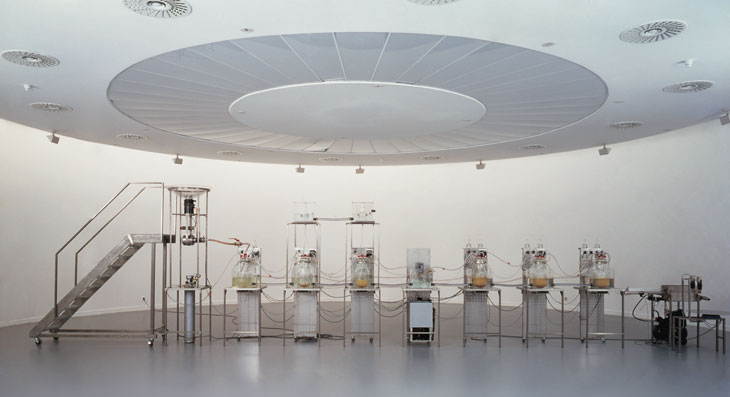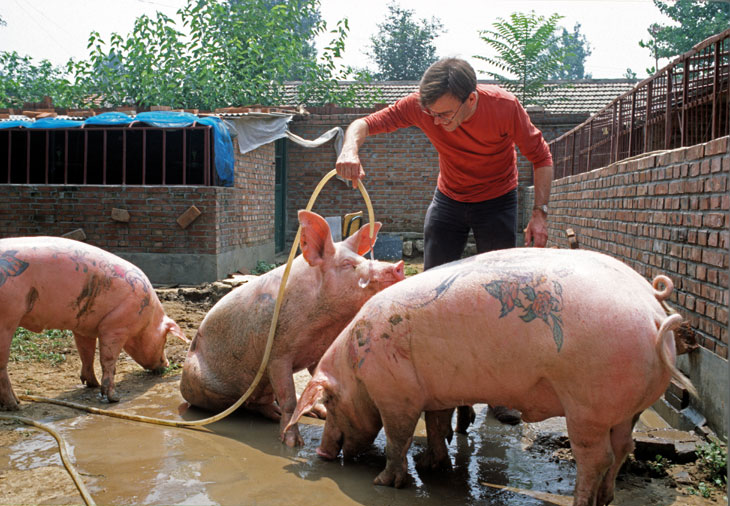On the eve of a major retrospective of his work at the Museum Tinguely, Basel, the Belgian artist Wim Delvoye talks to Apollo about merde-making machines, mass production, and the messy future of Europe
What does it mean to you to be exhibiting among the machines inutiles at the Museum Tinguely?
Jean Tinguely has always been a reference point for me – maybe not as a direct inspiration, but as a validation of my work. Anybody who has done things with machines after him has to be aware of his work. I especially love the ‘suicide machines’, designed to destroy themselves.
When I started making the Cloaca machines [which reproduce digestion and defecation], a different type of industrial or scientific revolution was underway from the one that had fascinated Tinguely with its motors and new sense of mobility. The Cloaca were developed in a world in which germ technology, nanotechnology, and DNA had become the leading scientific reference points – in the age of Dolly the sheep, in other words.
To begin with, I was worried that my machines didn’t look like art. Other machines were more poetic; Tinguely’s work was already rusty before he exhibited it, and wilfully made in a bricolage way. Now when I look back, I think my machines have a lot of bricolage, but somehow at that time I was very worried that there wasn’t enough of it to convince an audience that this was art.
Were you influenced by 18th-century automata, such as Vaucanson’s Digesting Duck?
That was something erudite journalists told me about when I started to exhibit the Cloaca. I always like to study my subject matter. If I’m tattooing pigs, then I study the history of tattooing. So I did start researching robots and automata, and in a couple of months I was ready for the next erudite journalist who asked the question. But I couldn’t say they influenced me.
How did the ever-increasing capacities of computers and robots influence the Cloaca series as it developed from 2000 onwards?
The PLC (programmable logic controller) of the first Cloaca was very large, which is why there’s a big control-box along with the electrical connections. Over time the technology evolved and those big boxes with the PLC became smaller and smaller; the most recent Cloaca [Cloaca Professional; 2010] is programmed and controlled from a laptop. I like the way the series shows technological evolution, but I also make fun of that progress. If you make use of scatology, you’re not suspected of being very serious, so it gives you a lot of freedom to make fun of things: how products are marketed, how publicity works, how consumers behave, how brands are built, how factories try to sell products to us that we don’t need…
They’re also machines that reproduce human functions. Do you ever think of them as a series of self-portraits?
No. When I started, we were still in the late Clinton years, and I’d really had enough of artists talking about their social identity or their sexual orientation. I thought it would be more original to deal with human identity in general: with men and women, rich and poor, and with every nation in the world. I also wanted to do something that would be understood by kids. So I thought, what is life? It is reproduction and digestion – everybody makes energy. The Cloaca are machines, they’re animals, they’re us. They’re all of us.
Shit is also the beginning of a lot of our culture in Europe. Holland wouldn’t exist without shit: the Dutch started to keep pigs, which made the land fertile over centuries, and finally they had good land for agricul-ture. Dutch people are very aware of that.

Cloaca Original (2000), Wim Delvoye, installation view at M HKA, Antwerp, 2000. Courtesy Studio Wim Delvoye, Belgium
Does your interest in such a universal subject reflect a more general desire to be a populist?
My work has a kind of popular ambition. I have always tried to make art that could be understood by everybody, and I’m very happy that people who wouldn’t go to a museum know the work. In the studio, we don’t differentiate between the people who want to collaborate with us: if somebody wants to make a mass product like a sticker album or toilet paper, that’s fine. But I don’t make signed and numbered editions. Editions are pretentious, because they try to disguise the fact that they are mass-produced.
Do most contemporary artists take themselves too seriously?
Certainly. Artists have never been so accepted into society as they are today. Can you imagine… when autumn starts, journalists ask me what books I’m going to buy for the winter, and I’m then required to make a list of five things; then the next day another guy calls and wants to know my opinion about the election in France. It’s amazing how artists are consulted like they are serious people and their opinion really matters. In reality when you meet them, yes, they’re charming, but that’s not the same as smart. And most of them are not very skilful!
You’re planning to open a gallery in Kashan, Iran. Why there?
Because I can afford it! And it will make a difference there. Imagine if I built a big museum in Brussels: it would be expensive, and almost impossible with the zoning laws, but it wouldn’t change the city. I wanted to do something outside Europe.
I also wanted to test the clichéd idea of Iran. The first time I went there I was nervous. Now it makes me smile. What a difference there is between arriving there and at JFK, where you get handled so badly. Being a contrarian pays off: if you buy an umbrella when the weather is nice, then you’ll have a very nice umbrella when it rains.
Does now feel like a good time to turn away from Europe?
I’m diversifying. We need to prepare for a European diaspora. It’s not going to get better here. We have become so provincial in our reactions and our fears, and we’re not producing anything or taking the lead technologically. I don’t think here we have an exciting century to look forward to.
Besides, I never belonged anywhere. When I was still a kid I was carving wood in Indonesia; I’ve tattooed pigs in China; and now I’m doing something in Iran. I’ve always had that globalist thing.
‘Wim Delvoye’ is at the Museum Tinguely, Basel, from 14 June–1 January 2018.
From the June 2017 issue of Apollo. Preview and subscribe here.
Unlimited access from just $16 every 3 months
Subscribe to get unlimited and exclusive access to the top art stories, interviews and exhibition reviews.











![Masterpiece [Re]discovery 2022. Photo: Ben Fisher Photography, courtesy of Masterpiece London](http://www.apollo-magazine.com/wp-content/uploads/2022/07/MPL2022_4263.jpg)
It’s time for the government of London to return to its rightful home